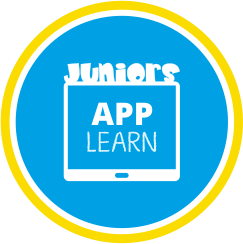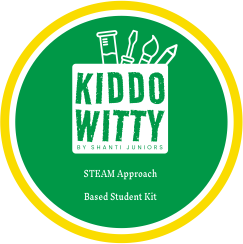


“The greatest gifts you can give your children are the roots of responsibility and the wings of independence.”- Denis Waitley.
We at Shanti Juniors pre-school follow the same. Our Little Juniors grasp on the basis of real life learning and understanding the world around them. We give them the freedom to explore and learn different teaching aids and concepts.



At Shanti Juniors, our stimulating environment and culturally appropriate curricular programs are thoughtfully designed to foster holistic development of children. We make them understand the basics step by step so that their learning foundation becomes strong and make them efficient to enter the world of formal education. We teach them in a manner that they become torchbearers in the society.
Teaching our children good manners at an early age cultivates a good character in them. Manners, life skills, proper etiquette, respecting elders and others are some of the important lessons a child needs to learn. At Shanti Juniors preschool, we use innovative ideas to teach them these important life lessons. Behavior in public, table manners, way of communication with elders and peers, healthy habits and daily routine activities are taught through positive reinforcement.
Apart from these, our little ones are also taught to socialize and make friends, adjust in groups, help friends through play and group activities giving them socio-emotional development.
We aim at developing the life skills and intra personal skills in our ‘Little Juniors’ which gives them an edge over their counterparts.
Shanti Juniors, which is amongst the top preschools in India doesn’t view childhood as a race to see who can read, write, and count. Instead, it treats early years as a time to learn and develop at their own pace.
At Shanti Juniors playschool, a child learns Sanskaar (values) through which s/he becomes Saakshar (educated) and ultimately the child becomes capable, Saksham (capable) to be independent and confident individuals and be empathetic towards their people and surroundings.
Hence, we say – Yahaan Shanti Juniors mein Sanskaar, Saakshar aur Saksham se hota hai bacchhon ka sampoorna vikas!
At Shanti Juniors pre-primary school, the Curriculum comprises of a balanced blend of the renowned Montessori Method, Waldorf Approach, High Scope Approach, Bank Street Approach, and Reggio Emilia Approach. Our international curriculum integrated with Indian ethnicity has been designed exclusively for holistic development of the child, taking in to account their cognitive, physical, social, emotional and sensorial abilities. These are the best ways of utilizing the utmost curiosity of children during their age. This is to bring your children in a vibrant and nurturing atmosphere where they make friends, share, explore & learn, play and enjoy in their daily classes with along with their friends.
Montessori Approach:
Montessori education is an educational approach developed by Italian physician and educator Maria Montessori based on her extensive research and understanding of children and characterized by an emphasis on independence, freedom within limits, and respect for a child’s natural psychological, physical, and social development.
Maria Montessori believed that education should prepare a person for all aspects of life. The materials and techniques designed by her are to promote a natural growth of learning in students. Working with these materials and techniques forms a pattern that children carry over naturally to reading, writing, and mathematics. Each skill is developed to interlock with another.
We have extracted few things from the Montessori approach. Our approach focuses on things such as Sensorial/ Training the senses (vision, hearing, touch, taste and smell), Repetition of exercises/Recapitulation of activities, Subjects such as Routines, personal care, good manners, cultural studies and arithmetic, self-help skills and order in environment i.e. classification and arrangement of toys in activity room,
The High-Scope is an early childhood education approach, used in preschool, kindergarten, childcare, or elementary school settings, was developed in Ypsilanti, Michigan in the 1960s. The philosophy behind High Scope is based on child development theory and research. The High Scope Curriculum has evolved to include the findings of ongoing cognitive-developmental and brain research. In its teaching practices, the High Scope Curriculum draws upon the work of developmental psychologist and educator Lev Vygotsky, especially the strategy of adult scaffolding
From the above, we have extracted few concepts such as we make child believe that the power to learn resides in the child, children’s independence is promoted, Children learn from experiences i.e.
A driving principle behind the Bank Street philosophy is that children can become lifelong learners by interacting with the environment around them, including other people, different places, and various things, and then interpret what they've just experienced. Students are offered myriad opportunities in which to do this—blocks, dramatic play, puzzles, field trips. (Source: Google)
We at Shanti Juniors Preschool, under the research team, have extracted important concepts of development and interaction from the Bank street Approach which consists of making our Little Juniors an explorer and experimentator, here the teacher encourages the process of discovering and understanding through our specially designed curriculum activities. Through this approach, the development of subjects such as History, Economics and Political science are taught by letting them celebrate National Holidays and making them understand their importance and significance. We assume that development unfolds at different times/ages for different children. We know, for example, that children learn to read at different ages. Or that one child will have better eye-hand coordination than another at the same age. Lastly, two children of the same age can differ in their interactions with others, one perhaps being more social and outgoing.
Reggio Emilia Approach:
The Reggio Emilia Approach is an educational philosophy focused on preschool and primary education. It was developed after World War II by a teacher, Loris Malaguzzi, and parents in the villages around Reggio Emilia in Italy. Following the war, people believed that children were in need of a new way of learning. The assumption of Malaguzzi and the parents was that people form their own personality during early years of development and that children are endowed with “a hundred languages” through which they can express their ideas. The aim of this approach is teaching how to use these symbolic languages (eg., painting, sculpting, drama) in everyday life. The program is based on the principles of respect, responsibility, and community through exploration and discovery in a supportive and enriching environment based on the interests of the children through a self-guided curriculum.(Source: Google)
Here, we initiate parental involvement through our program “Parents as Partners” where we orient our parents through Parent Orientation Program (POP) and Parent Partnership Meet (PPM), Celebrations. Also, we involve parents in school activities and contests. We also document all their learning and development through Assessment Register, Teacher’s Diary and My Learning Ladder.
Waldorf Approach:
Waldorf education, also known as Steiner education, is based on the educational philosophy of Rudolf Steiner, the founder of Anthroposophy. Its pedagogy emphasizes the role of imagination in learning, striving to integrate holistically the intellectual, practical, and artistic development of pupils. This focuses on practical, hands-on activities and creative play; to elementary education, which focuses on developing artistic expression and social capacities; and to secondary education, which focuses on developing critical reasoning and empathic understanding. The overarching goal is to develop free, morally responsible, and integrated individuals equipped with a high degree of social competence.
Here there is overall development i.e. development of Body, Soul and Spirit which are inculcated through Clay Modeling, Cooking activities, Physical activities, Role Plays, Drama, Drawing, Story Telling, etc.